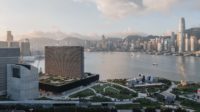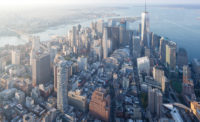Nicolas Berggruen isn’t the first billionaire to take an interest in architecture, but he may be the most ambitious. Last year Berggruen, the founder of a group of think tanks together known as the Berggruen Institute, announced that he had chosen Herzog & de Meuron to design the Institute’s home in Los Angeles.
Today Berggruen and the architects released renderings of the campus in the Santa Monica Mountains, just west of the Getty Center on a 447-acre parcel, over 90 percent of which will be preserved as open space. Parts of the Institute will burrow into the ground; other parts will float above it, reflecting the architects’ varied reactions to the “spectacular” topography, according to firm partner Jacques Herzog.
The floating structure, a concrete rectangle housing classrooms and meeting spaces, will cradle two massive spheres, the larger one a 250-seat lecture hall, which Berggruen says will be visible from the 405 Freeway. The smaller sphere will house a water tank. Paris-based landscape architects Michel Desvigne Paysagiste and Inessa Hansch are designing the grounds, and Gensler is the project’s architect of record.
The complex will include quarters for up to 50 visiting scholars and a 26,000-square-foot “chairman’s house” that Berggruen, a father of two, tells RECORD he plans to occupy for “as long as I am chairman.” Berggruen wouldn’t reveal the precise budget for the complex, but he said the will cost “hundreds of millions of dollars”—all of it his own money.
Berggruen is also planning a smaller facility in a 1924 building in the MacArthur Park section of L.A., to be renovated by the Spanish firm SelgasCano. In establishing the second venue, Berggruen hopes to create a more public presence near the city’s downtown, to complement what he calls the “secular monastery” designed by Herzog & de Meuron.
Herzog, speaking by phone from Switzerland, says that Berggruen “knows everything about architecture — he’s not just collecting architecture — he’s really thinking about it.”
The architect says the proposal marks the first time his firm has employed spherical elements, which interested him “not for their engineering,” as he says was the case for Buckminster Fuller, but for their form, which he called “both pure and stupid.”
The project is now entering the approval phase; Berggruen says he believes neighbors in Brentwood will prefer his plan over the 29 single-family homes the site’s previous owner had proposed before Berggruen bought it for $45 million in 2015. “A single organism, even a big one, should be preferable to lots of small organisms,” he says.
Meanwhile, the activities of the Institute continue, among them, the Berggruen Prize, a $1 million annual award for “a thinker whose ideas are helping to shape human self-understanding.”
Berggruen had his choice of architects. Through his private investment firm Berggruen Holdings, he has worked with David Adjaye, Richard Meier, and Shigeru Ban, and last year he named Frank Gehry to an Insitute advisory committee of prominent Angelenos.
Berggruen says that one factor that cut in favor of Herzog & de Meuron was that they had not yet built in L.A., making his project “unique.” He says that he had some 20 firms present ideas for the Institute, in an informal, unpaid competition, before settling on the Swiss firm. “He’s very demanding, and he talked to everyone,” says Herzog.
Asked about the similarities between the Institute and Peter Zumthor’s proposed LACMA building, which is also a wide, flat structure raised above the ground on columns, Berggruen responds, “You could say they are both by Swiss architects and they are both horizontal, but L.A. is a very horizontal city. Beyond that, one is hovering over an urban setting, the other over nature. Ours will be quite light,” he says, contrasting it with the Zumthor building, “but not so light that it looks like it could fly away.”









Post a comment to this article
Report Abusive Comment